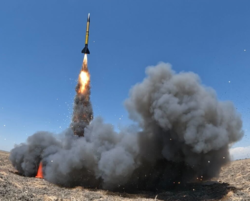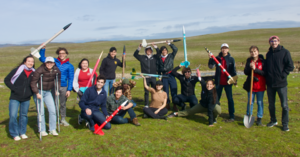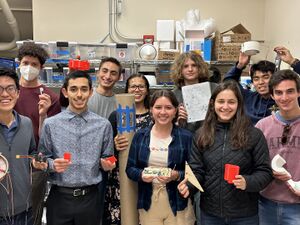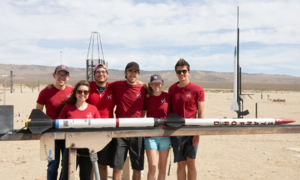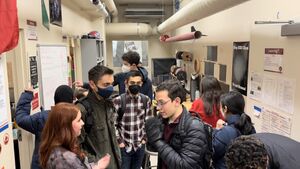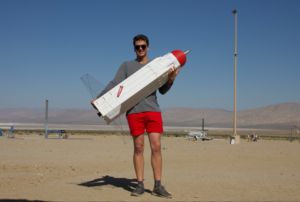Rockets Team
| Rockets |
|---|
| Part of the Rockets series |
| Project Daedalus |
| Charybdis • Pegasus • Prometheus • Talos |
| People |
| Dr. Hai Wang (Team Advisor) • Thomas White (Co-Lead) • William Koski (Co-Lead) |
| Launch Certifications |
| Level 1 • Level 2 • Level 3 |
| Miscellaneous |
| CFD Workflow • So You Want To... • Avionics |
| V • E |
The Rockets team is a student-led group striving to push the limits of high power rocketry. The team's long-term goal is a shot to the 100-km Karman Line, which forms the common definition of space. Along the way, the Rockets team competes regularly in the Intercollegiate Rocketry Engineering Competition (IREC), the Friends of Amateur Rocketry (FAR) 51025 Competition, and the Collegiate Propulsive Lander Challenge (CPLC). The Rockets team is structured into team projects, a High Power Rocketry (HPR) certification program, and research & development.
The active team projects are Fountain Hopper and Phoenix. Fountain Hopper is a lander rocket project competing in the CPLC. In Fall 2023, the project will begin custom hybrid engine development and will prototype an electric ducted fan for simulating a full scale lander vehicle aimed for launch within three years. Phoenix is a two-stage rocket project that competed in the FAR 51025 fully equipped with redundant avionics, dual recovery on both stages, and a traveling rover. In Fall 2023, Phoenix will be a two-stage rocket project competing in the 2024 Spaceport America Cup IREC.
In order to help our team members learn the fundamentals of rocketry, the Rockets team builds and launches Level 1, Level 2, and Level 3 high-power rockets. These are launched with national rocketry clubs, such as the Tripoli Rocket Association and the National Association of Rocketry.
The Rockets team Faculty Advisor is Dr. Hai Wang. The Rockets Propulsion team Faculty Advisory is Dr. Kentaro Hara. The current Rockets co-leads are @Evelyn Nutt and @Charlie Gordon
The rest of this page is dedicated to explaining everything an SSI Rockets team member needs to know.
Background
High Power RocketryProgram
A high powered rocket is defined as a rocket that weighs more than 1500 grams and contains a motor or motors containing more than 125 grams of propellant and/or rated at more than 160 Newton-seconds of total impulse. There are different classifications for motors and different levels of certification required to use these motors. These rockets fall in the Class 2 Rocketry category as long as their total impulse remains below 41,000 Ns. Class 3 rockets require motors that cannot be bought commercially (and are classified as ITAR defense articles).
| Class | Rating | Total Impulse (N-s) |
|---|---|---|
| Class 1 (Model Rocketry)
No certifications required |
||
| A | 1.26-2.5 | |
| B | 2.51-5.00 | |
| C | 5.01-10.0 | |
| D | 10.01-20.0 | |
| E | 20.01-40.0 | |
| F | 40.01-80.0 | |
| G | 80.01-160 | |
| Class 2 (High Power)
L1 |
||
| H | 160.01-320 | |
| I | 320-640 | |
| L2 | ||
| J | 640-1,280 | |
| K | 1,280-2,560 | |
| L3 | ||
| L | 2,560-5,120 | |
| M | 5,120-10,200 | |
| N | 10,200-20,500 | |
| O | 20,500-41,000 |
Level 1: H, I
There is no test required to acquire a Level 1 certification. Just a successful flight and recovery using an L1-class motor is required.
Level 2: J, K, L
The holder of an L1 certification (not necessarily from the organization they are attempting to obtain L2 certification from) must pass an examination on the subject of advanced rocketry concepts and have a successful flight and recovery using an L2-class motor.
Level 3: M, N, O and beyond
There are many requirements for an L3 flight. Check the NAR and TRA websites for further information.
Fountain Hopper
Fountain Hopper is a newer Rockets project that was established in August 2022. Fountain Hopper is a lander rocket project competing in the CPLC. In Fall 2023, the project will begin custom hybrid development and prototype an electric ducted fan for simulating a full scale lander vehicle that hopes to launch within three years.
Fountain Hopper is divided into five subteams as listed below.
- Avionics
- Controls
- Payload
- Propulsion
- Structures
Phoenix
Phoenix is a returning Rockets project that was active before the pandemic and again in the 2021-2022 academic year. Phoenix is a two-stage rocket project that competed in the FAR 51025, winning first place for reporting the closest apogee to 25,000 feet altitude fully equipped with redundant avionics, dual recovery on both stages, and a traveling rover. Soon, Phoenix will be a two-stage rocket project competing in the 2024 Spaceport America Cup IREC.
Phoenix is divided into five subteams as listed below.
- Avionics
- Payload
- Recovery
- Staging
- Structures
Getting involved in Rockets (after you finish "How to Join SSI")
Slack
Slack is the lifeblood of SSI. It is a messaging client that allows everyone within SSI to communicate. There are general channels (like #rockets), which allow us to push out general updates to everyone interested in the rockets team and direct messages in order to communicate with one person - although Slack has recently added a group messaging feature if you don’t want to make an entire channel for a 4 person chat - at a time. Notifications are pushed directly to your phone/computer/anything that has internet so that way we can infringe on all of your free time!
Rockets Schedule & Newsletter
For access to the Rockets Schedule for 2023-2024, head to this spreadsheet for all team project meetings, HPR program build sessions, onboarding sessions, and intended launch dates.
For the latest news on what the Rockets team is doing and planning, head to this link for the most recent quarterly Rockets team newsletter.
Meetings
The Rockets Team has general meetings, named "Rockets General," each quarter to report large team updates, to connect new members with a team project, to spread resources and forms for launches and individual project requests, and to eat some objectively good food. These meetings are usually held in a lecture hall.
The Rockets team projects have systems meetings every week, usually held in Durand or End Station III. They cover all relevant project updates and upcoming launch logistics, and function as work sessions where all team members are in the same place at once.
Each subteam in each team project meets at least once a week for work sessions in End Station III. Please check with the Slack channels for each team and subteam for up-to-date meeting times and locations.
Rockets Roster, Individual Project Proposal, & Pre-Flight Approval Form
To keep track of all its members, the Rockets team has a Rockets Roster form for all new and returning members to fill out annually. If you're a new or returning member, fill out this form so the Rockets co-leads know of your existence.
To manage budgeting and resources for individual projects, the Rockets team has an Individual Project Proposal form for any member intending to use SSI funds, materials, and resources for their own rocket project not involved in the HPR program. If you intend to build your own rocket in End Station III, fill out this form so the Rockets co-leads know of the existence of your project and can help support your efforts.
To ensure the safety of all Rockets members, the Rockets team has a Pre-Flight Approval Form for any member intending to launch a rocket at an SSI-sanctioned launch event with a high power motor provided by the Rockets team. If you intend to attend a launch with your rocket, no matter what team it belongs to, fill out this form so your intentions can be known to the Rockets co-leads.
Previous Knowledge
We don’t expect you to know very much about rocketry. If you do, great! But if you don’t, we will spend the time teaching you the fundamentals and give you the opportunities and resources to learn as much about rocketry as you’d like. Working on a project is the best way to exercise and synthesize with the knowledge you gain from working with theory.
Rocketry is a multi-disciplined topic. Here’s a non-exhaustive list of useful disciplines:
- Heat Transfer
- Thermodynamics
- Fluid Mechanics (incompressible and compressible flow)
- Physics
- Material Sciences
- Statics and Dynamics
- Controls
- Circuits
- Amatuer Radio
- Manufacturing
Introductions to many of these are available on So You Want To...
Time Commitment
Rocketry is difficult to master, but worth the tedious design process. The more time you put in, the better your project will turn out as well as experience less schedule slip.
L1 and L2 do not require more than 10 hours combined (since they come from kits). L3 projects require much more time since these are designed from scratch and need to go through our NASA-inspired design process.
Team projects take a couple hours a week at the minimum for systems and work sessions. Usually team projects are the most active in Spring Quarter as team projects prepare for competitions in June. Most team projects have activities occurring in End Station III everyday.
Rocket Naming Conventions, Acronyms, & Lingo
| 5k / 10k / 25k | Elevation of a rocket in feet. Measured from AGL (above ground level). |
| AGL | “Above ground level” - the standard way of measuring altitude of a rocket. As opposed to measurements from sea level. |
| Apogee | The highest point a rocket hits. |
| Arming | The process to prepare the rocket for launch on the launch pad. Extreme care must be done while arming, as the rocket could ignite or separate charge explode if done incorrectly. |
| AV Bay | Short for avionics bay, the part of the rocket that had computers for measuring altitude, and events like reigniting or parachute deployment. |
| Ballistic | A rocket which fails to deploy its parachutes and crashes into the ground. It’s happened many times. |
| Black power charge / BP charge / ejection charge | A highly combustible substance used to separate the rocket for recovery. An e-match ignites the charge, and the rapid pressure separates the rocket for a parachute to deploy. |
| Booster stage | The bottom stage of a two stage rocket, which detaches partway through the flight. |
| Bulkhead | A cylindrical block in the rocket used to separate components. Usually it separates the parachute from the rest of the rocket, to protect the rest of the rocket from the blast of the ejection charge. |
| Burn time | Number of seconds an engine burns. Slower burn times are more efficient, getting a higher altitude for a given thrust. Faster burns are more stable, as you are going faster once the launch rail is no longer guiding you. |
| Bus coefficient / bus factor | The number of people that can be hit by a bus before launch and still launch successfully. Legend has it the term was coined after someone in SSI was hit by a bus and the flight had to be canceled because no one else could do their job. Bus factor should always be greater than one, ideally 5 or more. |
| Carbon Fiber | A ultra high strength, lightweight material. Great for rocketry but also very expensive and difficult to manufacture. Also can be harmful to breath while cutting if proper safety precautions aren’t taken. Also blocks communication from the rocket, so not often only used in certain areas like reinforcing fins. |
| CG / center of gravity | The point of balance on the rocket. |
| CP / center of pressure | The average regions of the rocket where air resistance is applied. |
| CPLC | The 4-year long challenge that Fountain Hopper competes in. Established January 1, 2023. |
| Drogue chute | A small parachute that’s used for high elevation launches (usually higher than 5,000 ft). It slows the rocket until a main chute deploys. |
| Dry mass | Weight of rocket without motors. Last year ours was about 10 lbs per stage (20 lbs total for the rocket). |
| Epoxy | A high strength adhesive, often used with carbon fiber and fiberglass. You mix two resins together, and it dries in a number of hours. |
| Event | An action that occurs during flight, such as parachute deployment or engine ignition. |
| Failure modes | Reasons for a rocket to not have a successful launch. Common failure modes are tangled parachutes, electronics failure, engine explosion, and fins tearing off. |
| FAR | The launch site for more experimental launches at, like custom engines and multi-stage rockets. |
| FAR 51025 | The two-staged competition Phoenix competes in. |
| Fiberglass | A high strength, lightweight material with woven fibers. Often used for the body and fins of the rocket. Cheaper than carbon fiber (although still pricy), and conductive to signal it’s often the better choice of a rocket building material. |
| Fillets | Thick regions of glue around the fins for securing the fins to the body. |
| Fins | Surfaces on the aft of the rocket that keep the rocket stable. |
| Integration | Combining all subsystems onto the rocket. |
| Integration test | A dry run of combining everything onto the rocket before the launch to ensure it fits properly. |
| Launch lug | Small plastic guides sticking out the side of the rocket that hold the rocket to the launch rod. |
| Launch rail / launch rod | The support that keeps the rocket stable until it has sufficient velocity to keep itself stable. Usually 20 feet long, but we also have the option of 10 ft or 60 ft. |
| Main chute | In the case of a single chute rocket, the chute that deploys at apogee. In the case of a two chute rocket, the chute that deploys around 1,000 from the ground and brings the fall of the rocket to something that can be recovered without damage. |
| Minimum diameter | A rocket whose body tube acts as the motor tube, any smaller and the motor would no longer be able to fit inside the rocket. This is more efficient and makes motor assembly easier, however makes fins more challenging because they can no longer stick into the body, and launch lugs can’t be screwed into the airframe. |
| Motor | The thrust producing element of a rocket. In our case a solid fuel motor. |
| Motor casing | Aluminum casing that guides the thrust of the motor out the bottom. |
| Motor class | The power category of a motor. It’s a logarithmic scale, so the thrust from H to I is about double. Legally you can go up to O in California. |
| Motor grain | The fuel in the rocket which combusts to produce thrust. |
| Motor tube | A tube permanently fixed into the rocket that the motor casing slides into. |
| Nosecone | The top of the rocket. |
| Off the rail velocity | The speed of the rocket by the time it’s no longer contacting the guide rail. Usually this should be greater than 60 mph, but exact values vary depending on rocket and fin size, and wind. |
| Open rocket | Rocket simulation software for predicting stability caliper, apogee, center of gravity, and other flight statistics. |
| Over stable | When the rocket stability caliper is too high, usually greater than 2. The rocket can oscillate in the air. While not always bad, it adds additional stress to the rocket which risks it breaking, and makes the flight less efficient. |
| Phoenix | The name for our project, building a two stage rocket. |
| Project team | Project groups within SSI, like Phoenix, Olympus, Tobias, and Satellites. |
| Recovery | The parachutes and systems that hold the parachutes. |
| Rocket diameter | The diameter of the tube of the rocket. |
| Rockets team | The part of SSI building rockets. While the largest team in SSI, it’s far from the only active project. But it's obviously the best, don't get it twisted. |
| Scrubbed | When a launch is cancelled, usually referred to when the rocket is on the launch pad or close to it but can’t launch for some reason. |
| Separation testing | Ejecting the chutes in a controlled way on the ground to ensure the rocket can separate effectively. |
| Shock cord | The rope that connects the parachute to the rocket. |
| Solid Fuel | Type of motor that uses a reaction of elements that’s usually solid and stable without activation energy even when mixed. These generally burn fast and with lots of thrust. |
| SSI | Stanford Student Space Initiative. |
| Stability caliper | The distance between the CP and CG, divided by the rocket diameter. A stability less than 1 is unstable, and risks going out of control mid flight. Stability greater than about 2 risks being over stable. |
| Sustainer stage | The top stage of a two stage rocket. |
| Telemetry | Data received from the rocket during flight. Usually GPS position to find it after landing. |
| Thrust transfer ring / Thrust plate | Metal ring that sits at the bottom of the motor, and helps transfer thrust through the body of the rocket. Only necessary if the motor has a super high impulse. |
| Tip to tip | A method of reinforcing fins, in which carbon fiber sheets are epoxied to the fins and body tube. |
| Total impulse | The integration of thrust over time. This designates the letter for the engine. |
| Two Stage rocket | Rocket with multiple phases of engine power. |
| Zippering | When the airframe of the rocket gets cut from the parachute’s shock cord. Usually occurs because the rocket is falling too fast by the time the parachute opens, and the rocket decelerates so fast it rips a hole in it. |
Rockets Leadership
The logistics required to run a fully operational Rockets team can be too much for just two co-leads to handle. Rockets Leadership is a group of people who care about organizing the logistics behind launches and projects that the team is working on. If you show that you care and put in an exceptional amount of effort into your project, you can choose to be a part of this group.
Here is the current leadership structure, all of whom can be reached easily on Slack:
- Rockets Co-Leads
- HPRCC Mangers
- Project System Leads
- Subteam Leads
The Process
Design Reviews
Note: For a much more specific documentation check out 'The Process: From PDR to PLAR'. The document provides specific guidelines and expectations for each stage of the process.
As specified in NASA’s engineering design life cycle, multiple design reviews are used to assess the feasibility and practicality of both attempting and accomplishing a particular project. This includes a Preliminary Design Review (PDR example) to assess mission goals, risks, and criteria and is followed by a Critical Design Review (CDR). By CDR, a project is expected to have assessed specific hardware and software configurations for viability, addressed questions raised in the PDR, and considered manufacturing and production of their final product. Both stages include extensive criticism and evaluation by other SSI members and external entities.
The PDR demonstrates that the overall preliminary design meets all requirements with acceptable risk and within the cost and schedule constraints. It shows that the correct design options have been selected, interfaces have been identified, and verification methods have been described. Full baseline cost and schedules, as well as all risk assessment, management systems, and metrics, are presented.
The CDR demonstrates that the maturity of the design is appropriate to support proceeding to full-scale fabrication, assembly, integration, and test and that the technical effort is on track to complete the flight and ground system development and mission operations in order to meet overall performance requirements within the identified cost and schedule constraints. Progress against management plans, budget, and schedule, as well as risk assessment, are presented. The CDR is a review of the final design of the launch vehicle and payload system. All analyses should be complete and some critical testing should be complete.
The FRR examines tests, demonstrations, analyses, and audits that determine the overall system (all projects working together) readiness for a safe and successful flight/launch and for subsequent flight operations of the as-built rocket and payload system. It ensures that all flight and ground hardware, software, personnel, and procedures are operationally ready.
Immediately prior to launch, SSI will conduct a Launch Readiness Review (LRR). The LRR is performed on-site to verify procedural compliance and compliance with applicable safety codes. Furthermore, please note that launch-site safety officers will also be present to approve and assess your rockets.
After launch, SSI will conduct a Post-Launch Assessment Review (PLAR). The PLAR is an assessment of system in-flight performance. The PLAR will determine if mission success criteria were met, discuss any adverse events, enumerate lessons learned, and describe any recommended changes to the SSI Rockets program.
Budget
Rockets has a running budget in the SSI Google Drive (Stanford Student Space Initiative > Teams > Rockets > Budgeting). If you are uninformed of the reimbursement request and approval process, please reach out to the Rockets co-leads for guidance.
TRA and NAR
Tripoli Rocketry Association (TRA) and National Association of Rocketry (NAR) are the two major organizations that organize launches, certify members, and maintain specific standards that govern high power rocketry.
In order to launch high power rockets, you are required to be a member of either organization (Tripoli Membership / NAR Membership)
The closest Tripoli launch site to Stanford is Tripoli Central CA (near Fresno) and the closest NAR launch site is LUNAR (somewhat near Stockton). TCC holds HPR launches (max height 16,800’) on the 3rd Saturday of each month. LUNAR holds HPR launches (max height of 15,000’) on the 1st Saturday of each month in addition to low power launches (max height of 1000’) on the 3rd Saturday of each month at Moffett Field.
Launches
Here is the launch procedure as lifted from the Operating Principles and Risk Management document.
Once the team arrives at the launch site, the rules and regulations of the governing body sponsoring the launch will take precedence. Although procedure is likely to vary from site to site, the launch procedure usually occurs in this order:
Those attempting to fly a rocket approach the Range Safety Officer (RSO) and officers in charge of the launch, sign in (with their member numbers) and usually pay a launch fee. If the flyer is attempting to get a certification, they will fill out relevant forms to declare their intention (these and other useful documentation pertaining to both national rocketry associations are included in the Appendix).
Depending on the skill level of the flyer, there are two variations of what may occur.
In the non-certification flight case, the RSO will inspect the rocket and send the flyer to set up the rocket on the launch pad. This requires placing the rocket on the launch rails, placing the igniter in the motor, and checking the launch pad electronics for errors before returning to a safe distance from the launch pad.
In the case of a certification, the RSO and someone above the flyer’s certification level will inspect the rocket and send the flyer (and another more experienced member) to set up the rocket for launch. The same setup process occurs as stated above.
After the range has been cleared of spectators/flyers, the RSO announces each rocket and launches them one at a time (unless otherwise specified; an example of an exception is a drag race between two rockets).
Once the range is cleared of rockets, flyers recover their rockets.
If the flight is not a certification, the procedure ends here. Otherwise, the flyer shows his or her rocket to the RSO and has them sign off on the flyer’s paperwork if the flight is successful. The paperwork is then sent off to the headquarters of the organization and processed.
Resources
Other members are one of your best resources if you have any questions about rocketry. Other fantastic resources are laid out below.
Rockets Drive
There are tons of useful things in the Rockets folder!!!!! Here are descriptions of a few of those folders.
Wiki
Go here first for finding useful data on L1 certification procedures! You should add as much to the wiki as possible.
Archive
This holds all the older Rockets plans/documents/etc. Usually these documents are not particularly useful (which is why they are in the archive).
HPR Program
Fountain Hopper
Phoenix
Getting Nerdy: Textbooks and Manuals
This folder holds a collection of useful texts ranging from textbooks, manuals, NASA articles and technical reports. If you need to learn things, check out this document.
Launch Documentation
This holds all the launch documentation for upcoming launches and things like build slot signups, ride signups, rocket building instructions, required reading, pre-flight checklists, etc. Read through this folder and you’ll have a pretty damn good idea of launch logistics.
Rockets Operating Principles
This folder houses all of the operating principles, risk mitigation planning, and miscellaneous safety codes, documentation, and literally anything Stanford’s lawyers could possibly want from us. If you read the document you will have a very good understanding of how the team operates on an administrative level.
The Design Process
This folder houses all you need to know to design, fabricate and launch a rocket from a documentation standpoint. Read it.
